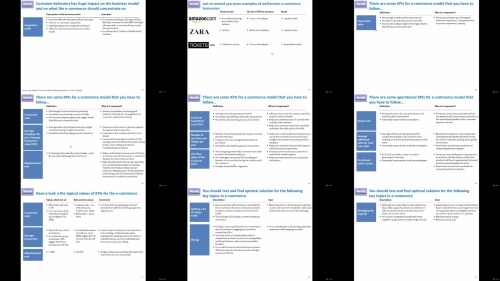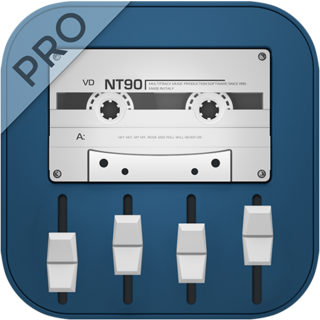Most Commented
Financial Modeling for Business Analysts and Consultants




Description material

Last updated 7/2024 MP4 | Video: h264, 1920x1080 | Audio: AAC, 44.1 KHz Language: English | Size: 1.09 GB | Duration: 3h 30m
Learn Financial Modeling in Excel that will allow you to participate in due diligence, strategy or turn around projects
What you'll learn
You will master financial modeling in Excel at the needed for business analysts and consultants level
Understand the main challenges in financial modelling
Perform the analyses of financial models
You will get access to +30 ready-made models that you can utilize for your purposes
Model your business in Excel
Estimate the value of your business
Requirements
Basic Excel
Basic knowledge of economics or finance
Description
What is the aim of this course?As a business analyst or a consultant, you will have to from time to time create financial models. They are a bit different than business models. In business models, you go into details of operations and you focus on getting the links on the KPIs. Those models are usually done for internal purposes, to manage in the right direction the business. Financial models on the other hand are more for external users. You concentrate on creating a picture of the business in a standardized, understood by everybody way. You also want to create financial statements: profit & loss statement, balance sheet statement, and cash flow statement. On top of that, you use financial statements for valuation purposes. The most typical situation when, as a business analyst or a consultant, you will have to prepare such a model is connected with selling or purchasing a company. You may be doing it on the sell side or on the buy side. Financial modeling is done as a part of strategy projects, turnaround projects, and due diligence. I will NOT teach you everything on financial modeling because it is simply not efficient (and frankly you don't need it). This course is organized around the 80/20 rule and I want to teach you the most useful (from a business analyst/consultant perspective) ways to go as fast as possible from rough description to working model in Excel that you can make more and more complicated. The aim of this course is that you are able to do a financial model of the business as fast as possible. If done properly, this course will transform you in a few days into a pretty good business analyst who knows how to create fast and efficiently financial models. This course is based on my 15 years of experience as a consultant in top consulting firms and as a Board Member responsible for strategy, performance improvement, and turn-arounds in the biggest firms from Retail, FMCG, SMG, B2B, and services sectors that I worked for. I have carried out or supervised over 90 different performance improvement projects in different industries that generated a total of 2 billion in additional EBITDA. On the basis of what you will find in this course, I have trained in person over 100 consultants, business analysts, and managers who now are Partners in PE and VC funds, Investment Directors and Business Analysts in PE and VC, Operational Directors, COO, CRO, CEO, Directors in Consulting Companies, Board Members, etc. On top of that my courses on Udemy were already taken by more than 224 000 students including people working in EY, Walmart, Booz Allen Hamilton, Adidas, Naspers, Alvarez & Marsal, PwC, Dell, Walgreens, Orange, and many others.I teach step by step on the basis of Excel files that will be attached to the course. We will go through a real-life example of a business and create the financial model for it. To make the best out of the course you should follow my steps and repeat what I do with the data after every lecture. Don't move to the next lecture if you have not done what I show in the lecture that you have gone through. I assume that you know basic Excel so the basic features (i.e. how to write formulas in Excel) are not explained in this course. I concentrate on intermediate and advanced solutions and purposefully get rid of some things that are advanced yet later become very inflexible and useless (i.e. naming the variables). To every lecture, you will find attached (in additional resources) the Excel shown in the Lecture so as a part of this course you will also get a library of ready-made analyses that can, with certain modifications, be applied by you in your work. Why have I decided to create this course? This course is a part of my attempt to help business analysts and consultants gain fast useful knowledge that will help them excel at their work. I have done 10 other courses that will help you become a great business analyst or consultant. I have covered already: hacks and tricks in Excel, business modeling, market research, management productivity hacks, and others. Now you have the opportunity to learn financial modeling in Excel In what way will you benefit from this course? The course is a practical, step-by-step guide loaded with tons of analyses, tricks, and hints that will significantly improve the speed with which you do the analyses as well as the quality of the conclusions coming out of available in your company data. There is little theory – mainly examples, a lot of tips from my own experience as well as other notable examples worth mentioning. Our intention is that thanks to the course you will know: What is the difference between business models and financial models? How to model cost positions and balance sheet positions? How to create on the basis of these financial statements: profit and loss statement, balance sheet statement, and cash flow statements How to make sure that there is integrity in the model? What analyses and conclusions you can draw from the financial model? You can also ask me any question either through the discussion mode or by messaging me directly. How the course is organized? The course is divided currently into 10 sections and will be adding new sections to address other important issues. Currently, you will find the following sections: Introduction. We begin with a little intro to the course Modeling of Profit & Loss account. In this section, we start by showing how to model cost positions (except for Depreciation)and how to create on the basis of this a profit & loss statement Capex and Depreciation. Capex and Depreciation are some of the most difficult elements that you will model in Excel. Therefore, we have created a separate section devoted just to this subject. In this section, you will learn how to follow specific groups of assets, track their gross and net value, and calculate depreciation. Working Capital. Working capital is crucial to the business as it defines how much money you have to have engaged in the business. I will show you how to model specific positions of Working Capital Debt. You may need external sources of financing for the company. I will show you how to model loans and get the necessary info to create a balance sheet later. Equity. In this section, I will show you how to model equity and all relations with shareholders Balance sheet modeling. Here we get everything together to model the balance sheet statement. Cash flow modeling. Here we get everything together to model the cash flow statement. Here we will check the integrity of the model as well. Analyses of the Financial Model. In the end, on the basis of a ready model, I will try to draw conclusions that will show us whether the business we have been analyzing is interesting or not Valuation. In this section, I will show you the main valuation methods. We will look at DCF and the Multiplier methodBusiness modeling. In many cases, you will have no time to do a full financial model. In such situations, you may resort to creating a business model. A business model will usually have only a P&L statement. In some cases also simplified the Cash Flow statement. In this section, we will see how you can create such models. You can also get access to more than 30 models. You will see how to model e-commerce, marketplace, real estate, subscription businesses, and many more. You will also be able to download many additional resources Excels with analyses shown in the courseLinks to additional presentations and moviesLinks to books worth reading At the end of my course, students will be able to. You will master financial modeling in Excel at the needed for a business analyst and consultant levelUnderstand the main challenges in financial modelingPerform the analyses of the financial modelYou will get a ready model that you can utilize for your purposesWho should take this course? Who should not? Business analystsResearchersControllersConsultantsSmall and medium business ownersStartups foundersWhat will students need to know or do before starting this course? Basic ExcelBasic knowledge of economics or finance
Overview
Section 1: Introduction
Lecture 1 What the course will be about
Lecture 2 About me
Lecture 3 What to do if a blurry image appears
Lecture 4 How to find additional resources
Lecture 5 Difference between financial model and business model
Lecture 6 Essential Finance & Accounting
Lecture 7 Our approach to modelling
Lecture 8 Bottom-up approach
Lecture 9 Estimating the costs of a wedding – Introduction
Lecture 10 Estimating the costs of a wedding – Partial Solution
Lecture 11 Estimating the costs of a wedding – Excel Part 1
Lecture 12 Estimating the costs of a wedding – Excel Part 2
Lecture 13 Case Introduction
Section 2: Modeling of Profit & Loss Account
Lecture 14 How to make the most of the course
Lecture 15 Profit and loss intro
Lecture 16 Sales
Lecture 17 Materials and Energy
Lecture 18 External services
Lecture 19 Taxes & Payments
Lecture 20 Payroll
Lecture 21 Other Costs
Section 3: Capex and Depreciation
Lecture 22 Modeling Capex and depreciation - introduction
Lecture 23 Intangibles - modeling of gross value, net value and depreciation
Lecture 24 Machinery - modeling of gross value, net value and depreciation
Lecture 25 Adding depreciation to the P&L
Section 4: Working Capital
Lecture 26 Introduction to Working Capital
Lecture 27 Inventory of materials, WIP and finished goods
Lecture 28 Receivables
Lecture 29 Liabilities
Lecture 30 Corporate tax and final working capital estimation
Section 5: Debt
Lecture 31 Introduction to debt modeling
Lecture 32 Old loans
Lecture 33 New loan
Lecture 34 Interest paid and interest earned
Section 6: Equity
Lecture 35 Introduction to Equity
Lecture 36 Equity modeling
Section 7: Balance sheet modeling
Lecture 37 Introduction to Balance sheet modeling
Lecture 38 Fixed assets
Lecture 39 Current Assets
Lecture 40 Own capital
Lecture 41 Current liabilities
Lecture 42 Balance sheet - summary
Section 8: Cash flow modeling
Lecture 43 Cash Flow introduction
Lecture 44 Operational cash flows
Lecture 45 Investment cash flows
Lecture 46 Cash flow from financial activities
Lecture 47 Shareholders influence on Cash Flow
Lecture 48 Final Cash Flow
Section 9: Analyses of the Financial Model
Lecture 49 Introduction to Analyses
Lecture 50 Profit & Loss analyses
Lecture 51 Cash Flow analyses
Lecture 52 Possible improvements to be further analysed
Lecture 53 Alternative wasy to model Sales
Lecture 54 Alternative wasy to model Variable Costs
Lecture 55 More on Financial Analyses
Section 10: Valuation
Lecture 56 Introduction to Valuation
Lecture 57 Introduction to DCF method
Lecture 58 Difference between FCFF and FCFE
Lecture 59 DCF method of valuation applied to FCFF
Lecture 60 DCF method of valuation applied to FCFE
Lecture 61 Introduction to using multipliers for valuation
Lecture 62 Enterprise to EBIT or EBITDA
Lecture 63 Price per Earning multiplier
Lecture 64 More on Valuation
Lecture 65 How to increase the value of the business
Section 11: Business Modeling - examples
Lecture 66 Introduction to business modeling
Lecture 67 Difference between financial model and business model
Lecture 68 Mechanics of business model for a consulting firm
Lecture 69 The business model of a consulting firm in Excel - Capacity and revenues
Lecture 70 The business model of a consulting firm in Excel - costs and profit & loss
Lecture 71 E-commerce Introduction
Lecture 72 E-commerce business model
Lecture 73 Business model of a restaurant in Excel - basic model
Lecture 74 Business model of a restaurant in Excel - advanced model
Lecture 75 Other Business models
Section 12: Conclusions
Lecture 76 Bonus Lecture
Business analysts,Researchers,Controllers,Consultants,Small and medium business owners
without You and Your Support We Can't Continue
Thanks for Buying Premium From My Links for Support
Click >>here & Visit My Blog Daily for More Udemy Tutorial. If You Need Update or Links Dead Don't Wait Just Pm Me or Leave Comment at This Post
Say "Thank You"

Download

Warning! You are not allowed to view this text.

Warning! You are not allowed to view this text.
Join to our telegram Group
Information
Users of Guests are not allowed to comment this publication.
Users of Guests are not allowed to comment this publication.
Choose Site Language
Recommended news
Commented


![eM Client Pro 9.2.1735 Multilingual [Updated]](https://pikky.net/medium/wXgc.png)






![Movavi Video Editor 24.0.2.0 Multilingual [ Updated]](https://pikky.net/medium/qhrc.png)

